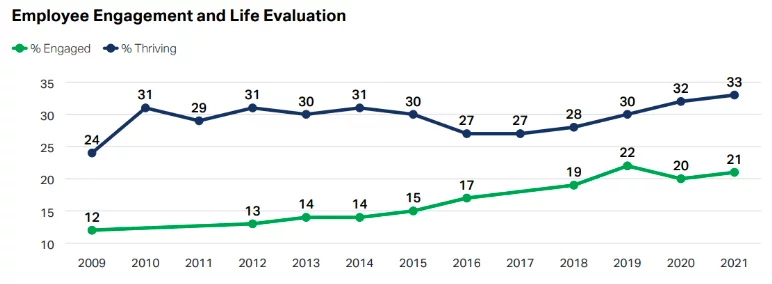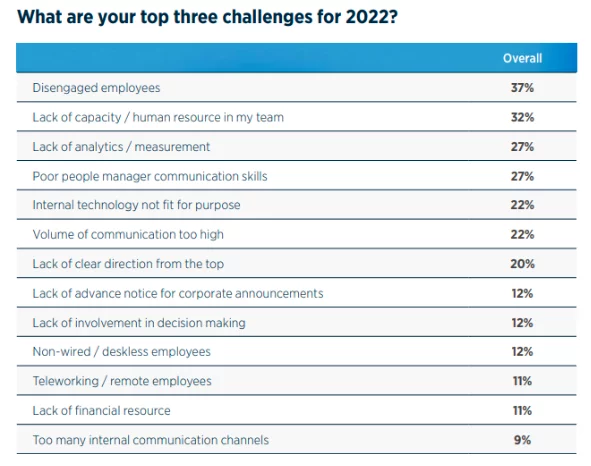Are you struggling to keep your employees engaged in these post-pandemic times? You have come to the right page. In this article, we’ll discuss practical tactics to improve your internal communications and enhance your employee productivity and morale.
Let’s get started. What sets successful organizations apart from others? The answer is simple. Successful organizations have effective strategies for internal communications.
Effective internal communication in the workplace is beneficial in many ways:
- It’s vital for keeping your team informed and safe
- It can help to attract highly-skilled employees through referrals
- Can improve employee morale, retention, and productivity
- It can lead to improved b2c and b2b customer experience
- It can lead to greater collaboration and innovation
No doubt, good internal communication is the glue that holds companies together and builds trust and transparency among employees and employers. It’s one of the most effective ways to build employee engagement.
Interestingly, studies show employee engagement is low. Only 21% of employees feel engaged at work.

The same survey shows that disengaged employees cost the world $7.8 trillion in lost productivity.
Understandably, achieving effective internal communication can be challenging. According to a 2021/22 global State of the Sector survey by Gallup, employee disengagement is ranked the biggest challenge by 37% of respondents.

It’s worth mentioning that internal communication is more than just sharing information. It involves sharing the right kind of information using the right channels, at the right time.
Generally, there are 8 types of internal communications you need to know:
- Top-down communications
- Crisis communication
- Peer-to-peer communication
- Bottom-up communication
- Campaign communications
- Culture communications
- Information communications
- Change communications
Let’s see how you can improve these types of internal communication.
1. Assess your existing internal communication strategy
You’ve probably put in place an internal communication system of some kind in your organization. If you don’t have one, create a powerful internal communication strategy now. You can learn how to create one by doing a communications degree.
To improve your internal communications, start by determining what’s working and what’s not with your existing strategy. In this case, you need to focus on the following things:
- Assess the performance of your internal communication system
- Determine its strengths and weaknesses
- Determine the goals for your internal communication processes and how you plan to achieve them
Taking a holistic approach to assessing your internal communication strategy will help you find ways to improve it.
2. Find out the most effective internal communication tools
The internet is awash with tons of communication platforms thus it can be overwhelming to determine the best one for your organization. However, it doesn’t have to be. When deciding the most effective internal communication tools to use, focus on the following traits:
- Accessibility: The tool should be accessible to all your employees.
- Real-time communications: The tool should support real-time communication between you and your employees.
- Ease of use: Your communication tools should be user-friendly.
- Integrations: The tools should be compatible with the ones you’re already using.
Granted, video conferencing triumphs over emails.
Zoom and Microsoft Teams are some of the best video conferencing software platforms platforms you can use to keep employees engaged and enhance internal communications.
Try out the different communication tools available and find what works best for your team.
For instance, if you feel that tools such as Slack or email do not pass your message effectively, you can record short videos using a video communication software like Loom.
Also, you can use the effective email newsletter templates to share updated information about your latest products and services. These newsletters templates are designed for the internal communication as well.
3. Keep your internal communication processes simple
Simplicity and clarity are the two key things to put in mind when creating an internal communication strategy. The last mistake you want to make is to overload employees with complex and extensive information. Ensure you’re sending the right amount of information at any time.
Keep all your communications brief, informative, simple, and straight to the point. For instance, you can manage and convey information in your sales department with the help of a sales crm tool such as Copper CRM tool. You can learn more about this tool in the Copper CRM review post.
Remember to keep your messages as interesting as possible to grab and hold your employees’ attention as well. That’s how you can connect with them and still deliver your message. Also, ensure your messages are relevant to your audience.
4. Try to engage instead of announcing
Much of your internal communications will be about company announcements such as developing news, events, successes, etc. Even though this has long been the way of sharing information, it can be the reason why your employees’ productivity and performance is dwindling.
Why? Because top-down communication can be controlling and this makes employees feel unheard. This is especially true if you end up posting on Instagram about important events without letting your employees know.
According to a recent survey by the Workforce Institute, 86% of employees feel people at their workplace are not heard fairly or equally.
In the same survey, 74% of employees who feel their voice is heard feel more engaged at work and 71% feel more effective at their job.

You must discourage one-way communication and encourage dialogue between company management and employees. In this case, encourage your employees to respond to your messages.
Whether the communication is virtual or in person, ensure all your employees’ voices are heard, which brings us to the next point.
5. Encourage employee feedback
Encouraging employee feedback is also another powerful strategy to improve your internal communications. To make employees feel their voices are heard, create channels for employee response and feedback.
Encouraging employee feedback can be helpful in many ways:
- Honest employee feedback can help you identify areas to improve your internal operations and company culture
- It can help you detect and resolve issues early
- Helps identify shortcomings in the top management
- Makes employees feel valued and appreciated
- It can help to avert conflicts among employees
- Can help you assess the success of your internal communication strategy
Create effective channels for employees to share their ideas either openly or anonymously. Assure them that their views will be used to improve the status quo. This will help to build trust and confidence—two key elements for a healthy workplace. Note that employees may be hesitant to provide feedback due to fear.
Here are a few ways to remove the fear and encourage your employees to give feedback:
- Create anonymous surveys
- Recognize your employees’ feedback
- Create events that encourage dialogue
- Accept the feedback you receive positively
6. Measure your success
In the end, you need to determine whether your internal communication strategy is delivering your goals. What did you want your internal communication strategy to achieve?
For some companies, the aim of creating a communication strategy will be to reduce staff turnover. For, others it will be to improve productivity and build trust and confidence among employees and other stakeholders. No matter your goals, be sure to analyze how effective your strategy is in achieving them.
That said, it can be difficult to measure your success here. For platforms like LinkedIn, you could have LinkedIn analytics tools, but here you would have to analyze your internal communication tools to figure out how engaged your employees are on LinkedIn platform.
Take a step to improve your internal communications
Having a robust internal communication strategy will help you improve employee engagement, build a better relationship with employees, boost retention, and increase productivity.
Here’s a quick recap of some changes you can make to improve your internal communications:
- Assess your existing internal communication strategy and identify areas of improvement
- Use effective communication tools
- Establish simple internal communication processes
- Engage your employees when communicating
- Encourage employee feedback
- Measure the effectiveness of your internal communication strategy
Implement these 6 practical strategies today to improve your internal communications and realize the great benefits that come with it.


